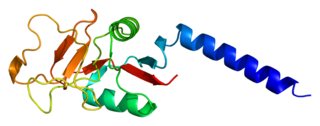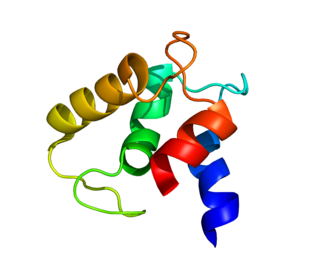Protein ERGIC-53 also known as ER-Golgi intermediate compartment 53 kDa protein or lectin mannose-binding 1 is a protein that in humans is encoded by the LMAN1 gene. [5] [6] [7]
Protein ERGIC-53 also known as ER-Golgi intermediate compartment 53 kDa protein or lectin mannose-binding 1 is a protein that in humans is encoded by the LMAN1 gene. [5] [6] [7]
ERGIC-53 (also named LMAN1) is a type I integral membrane protein localized in the intermediate region (ERGIC) between the endoplasmic reticulum and the Golgi, presumably recycling between the two compartments. The protein is a mannose-specific lectin and is a member of a novel family of plant lectin homologs in the secretory pathway of animal cells. Mutations in the gene are associated with a coagulation defect. Using positional cloning, the gene was identified as the disease gene leading to combined deficiency of factor V-factor VIII, a rare, autosomal recessive disorder in which both coagulation factors V and VIII are diminished. [8] [7] MCFD2 is the second gene that leads to combined deficiency of factor V-factor VIII. [9] ERGIC-53 and MCFD2 form a protein complex and serve as a cargo receptor to transport FV and FVIII from the ER to the ERGIC and then the Golgi, [10] as illustrated here. [8]
LMAN1 mutational inactivation is a frequent and early event potentially contributing to colorectal tumorigenesis. [11]

The Golgi apparatus, also known as the Golgi complex, Golgi body, or simply the Golgi, is an organelle found in most eukaryotic cells. Part of the endomembrane system in the cytoplasm, it packages proteins into membrane-bound vesicles inside the cell before the vesicles are sent to their destination. It resides at the intersection of the secretory, lysosomal, and endocytic pathways. It is of particular importance in processing proteins for secretion, containing a set of glycosylation enzymes that attach various sugar monomers to proteins as the proteins move through the apparatus.
A congenital disorder of glycosylation is one of several rare inborn errors of metabolism in which glycosylation of a variety of tissue proteins and/or lipids is deficient or defective. Congenital disorders of glycosylation are sometimes known as CDG syndromes. They often cause serious, sometimes fatal, malfunction of several different organ systems in affected infants. The most common sub-type is PMM2-CDG where the genetic defect leads to the loss of phosphomannomutase 2 (PMM2), the enzyme responsible for the conversion of mannose-6-phosphate into mannose-1-phosphate.

COPI is a coatomer, a protein complex that coats vesicles transporting proteins from the cis end of the Golgi complex back to the rough endoplasmic reticulum (ER), where they were originally synthesized, and between Golgi compartments. This type of transport is retrograde transport, in contrast to the anterograde transport associated with the COPII protein. The name "COPI" refers to the specific coat protein complex that initiates the budding process on the cis-Golgi membrane. The coat consists of large protein subcomplexes that are made of seven different protein subunits, namely α, β, β', γ, δ, ε and ζ.

Factor VIII (FVIII) is an essential blood-clotting protein, also known as anti-hemophilic factor (AHF). In humans, factor VIII is encoded by the F8 gene. Defects in this gene result in hemophilia A, a recessive X-linked coagulation disorder. Factor VIII is produced in liver sinusoidal cells and endothelial cells outside the liver throughout the body. This protein circulates in the bloodstream in an inactive form, bound to another molecule called von Willebrand factor, until an injury that damages blood vessels occurs. In response to injury, coagulation factor VIII is activated and separates from von Willebrand factor. The active protein interacts with another coagulation factor called factor IX. This interaction sets off a chain of additional chemical reactions that form a blood clot.

Von Willebrand factor (VWF) is a blood glycoprotein involved in hemostasis, specifically, platelet adhesion. It is deficient and/or defective in von Willebrand disease and is involved in many other diseases, including thrombotic thrombocytopenic purpura, Heyde's syndrome, and possibly hemolytic–uremic syndrome. Increased plasma levels in many cardiovascular, neoplastic, metabolic, and connective tissue diseases are presumed to arise from adverse changes to the endothelium, and may predict an increased risk of thrombosis.

Protein S is a vitamin K-dependent plasma glycoprotein synthesized in the liver. In the circulation, Protein S exists in two forms: a free form and a complex form bound to complement protein C4b-binding protein (C4BP). In humans, protein S is encoded by the PROS1 gene. Protein S plays a role in coagulation.

The lectin pathway or lectin complement pathway is a type of cascade reaction in the complement system, similar in structure to the classical complement pathway, in that, after activation, it proceeds through the action of C4 and C2 to produce activated complement proteins further down the cascade. In contrast to the classical complement pathway, the lectin pathway does not recognize an antibody bound to its target. The lectin pathway starts with mannose-binding lectin (MBL) or ficolin binding to certain sugars.

Mannan-binding lectin serine protease 1 also known as mannose-associated serine protease 1 (MASP-1) is an enzyme that in humans is encoded by the MASP1 gene.

Mannan-binding lectin serine protease 2 also known as mannose-binding protein-associated serine protease 2 (MASP-2) is an enzyme that in humans is encoded by the MASP2 gene.
The coatomer is a protein complex that coats membrane-bound transport vesicles. Two types of coatomers are known:

Mannose-binding lectin (MBL), also called mannan-binding lectin or mannan-binding protein (MBP), is a lectin that is instrumental in innate immunity as an opsonin and via the lectin pathway.

Coagulation factor XIII B chain is a protein that in humans is encoded by the F13B gene.

VIP36-like protein is a protein that in humans is encoded by the LMAN2L gene.

Multiple coagulation factor deficiency protein 2 is a protein that in humans is encoded by the MCFD2 gene. Mutations in MCFD2 cause the combined deficiency of factor V and factor VIII (F5F8D), a recessive bleeding disorder. MCFD2 and ERGIC-53 form a protein complex and serve as a cargo receptor to transport FV and FVIII from the ER to the Golgi body. Mutations in LMAN1 gene also cause F5F8D.

Protein YIF1A is a Yip1 domain family proteins that in humans is encoded by the YIF1A gene.

Endoplasmic reticulum-Golgi intermediate compartment protein 2 (ERGIC2) is a gene located on human chromosome 12p11. It encodes a protein of 377 amino acid residues. ERGIC2 protein is also known as PTX1, CDA14 or Erv41.

Vesicular integral-membrane protein VIP36 is a protein that in humans is encoded by the LMAN2 gene.

Endoplasmic reticulum-Golgi intermediate compartment protein 3 is a protein that in humans is encoded by the ERGIC3 gene. It has been reported to be regulated by micro RNAs and may be important in a cancer.

In the fields of biochemistry and cell biology, the cation-dependent mannose-6-phosphate receptor (CD-MPR) also known as the 46 kDa mannose 6-phosphate receptor is a protein that in humans is encoded by the M6PR gene.

In molecular biology the L-like lectin domain is a protein domain found in lectins which are similar to the leguminous plant lectins.